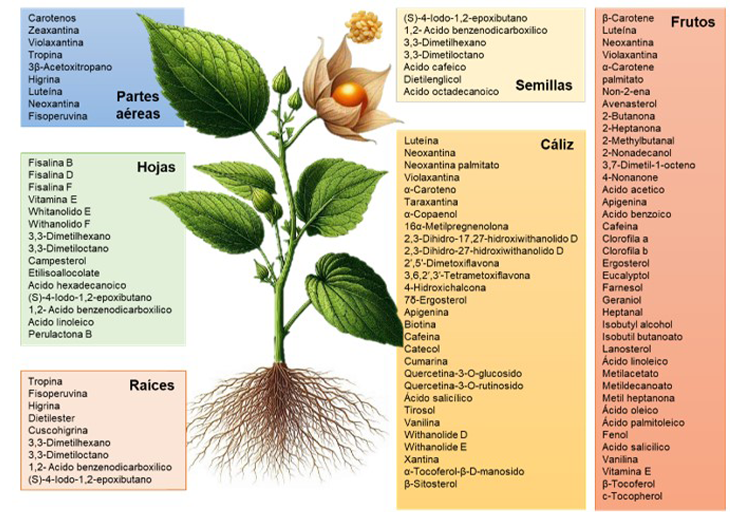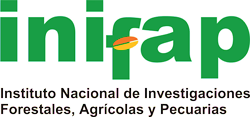Aguaymanto L.: fitoquímicos y aplicaciones en la salud humana
DOI:
https://doi.org/10.29312/remexca.v16i5.3682Palabras clave:
Physalis peruviana, fitoquímicos, nutrición, beneficios saludResumen
El ‘aguaymanto’ es una especie de gran importancia socioeconómica en diferentes países de América Latina y África. A nivel de fitoquímicos, esta especie presentan una variedad de fitoquímicos de importancia biológica. Por lo cual, este trabajo tiene como objetivo proporcionar un resumen exhaustivo de Physalis peruviana ‘aguaymanto’, enfocándose en sus fitoquímicos y sus aplicaciones en la salud humana. Este trabajo fue realizado en 2024 indica que, a nivel de sus frutos, se encuentran terpenos, compuestos fenólicos, alcoholes, esteroides y withanólidos, destacando a los carotenoides y flavonoides, niveles reducidos de grasa, alto contenido de agua y vitaminas A, B3, B6, C y E, así como de los minerales calcio, potasio, fósforo y magnesio. Esta riqueza en fitoquímicos y nutrientes del aguaymanto se traduce en beneficios significativos para la salud, gracias a sus propiedades antioxidantes, antibacterianas y antiproliferativas. En particular, los cálices y extractos de hojas del aguaymanto han demostrado actividad antihepatotóxica, antifibrótica y antidiabética. En resumen, el aguaymanto presenta un óptimo contenido nutricional y es necesario optimizar la biodisponibilidad de sus componentes para aprovechar plenamente sus beneficios. Debido a su potencial como componente prometedor en alimentos funcionales y fitomedicina, es necesario realizar evaluaciones más profundas sobre su impacto en el bienestar de la humanidad.
Descargas
Citas
Arun, M. and Asha, V. V. 2007. Preliminary studies on antihepatotoxic effect of Physalis peruviana Linn. (Solanaceae) against carbon tetrachloride induced acute liver injury in rats. J. Ethnopharmacol. 111(1):110-114. Doi:10.1016/j.jep.2006.10.038.
Asilbekova, D. T.; Ul’chenko, N. T. and Glushenkova, A. I. 2016. Lipids from Physalis alkekengi. Chemistry of Natural Compounds. 52(1):96-97. Doi:10.1007/s10600-016-1556-0.
Ballesteros-Vivas, D.; Alvarez-Rivera, A.; Sánchez, C. A.; Ibañez, E.; Parada-Alfonso, F. and Cifuentes, A. 2019. A multi-analytical platform based on pressurized-liquid extraction, in vitro assays and liquid chromatography/gas chromatography coupled to high resolution mass spectrometry for food by-products valorisation. Part 1: whitanolides-rich fractions from goldenberry (Physalis peruviana L.) calyces obtained after extraction optimization as case study. Journal of Chromatography A. 1584(1):155-164. Doi:10.1016/j.chroma.2018.11.055.
Bazalar, M. S.; Nazareno, M. A. and Viturro, C. I. 2019. Nutritional and antioxidant properties of Physalis peruviana l. fruits from the Argentinean northern Andean region. Plant Foods for Human Nutrition. 74(1):68-75. Doi:10.1007/s11130-018-0702-1.
Carazo, A.; Macáková, K.; Matoušová, K.; Krčmová, L. K.; Protti, M. and Mladěnka, P. 2021. Vitamin A update: forms, sources, kinetics, detection, function, deficiency, therapeutic use and toxicity. Nutrients. 13(5):1703-1739. Doi: 10.3390/nu13051703.
Chasquibol, N. A. and Yácono, J. C. 2015. Composición fitoquímica del aceite de las semillas del fruto del ‘aguaymanto’, Physalis peruviana L. Revista de la Sociedad Química del Perú. 81(1):311-318. http://www.scielo.org.pe/pdf/rsqp/v81n4/a03v81n4.pdf.
Chiu, C. C.; Haung, J. W.; Chang, F. R.; Huang, K. J. and Huang, H. M. 2013. Golden berry-derived 4⊎-hydroxy whitanolide E for selectively killing oral cancer cells by generating ROS, DNA damage, and apoptotic pathways. PLoS One. 8(5):e64729. Doi:10.1371/journal.pone.0064739.
Cicchetti, E.; Duroure, L.; Borgne, E. and Laville, R. 2018. Upregulation of skinaging biomarkers in aged NHDF cells by a sucrose ester extract from the agroindustrial waste of Physalis peruviana calyces. Journal of Natural Products. 81(1):1946-1955. Doi:10.1021/acs.jnatprod.7b01069.
Cortés-Díaz, G.; Prieto, G. A. and Rozo, W. E. 2015. Bromatological and physicochemical characterization of Physalis peruviana L., and its potential as a nutraceutic food. Ciencia en Desarrollo. 20(1):87-97. Doi:10.19053/01217488.3653.
Eken, A.; Ünlü-Endirlik, B.; Baldemir, A.; İlgün, S.; Soykut, B. and Erdem, O. 2016. Antioxidant capacity and metal content of Physalis peruviana L. fruit sold in markets. Journal of Clinical and Analytical Medicine. 7(3):291-294. Doi:10.4328/jcam.2709.
Etzbach, L.; Pfeiffer, A.; Weber, F. and Schieber, A. 2018. Characterization of carotenoid profiles in goldenberry (Physalis peruviana L.) fruits at various ripening stages and in different plant tissues by HPLC-DAD-APCI-MS. Food Chemistry. 245(1):508-517. Doi: 10.1016/j.foodchem.2017.10.120.
Fan, H.; Huang, W.; Guo, Y.; Ma, X. and Yang, J. 2022. α-Linolenic acid suppresses proliferation and invasion in osteosarcoma cells via inhibiting fatty acid synthase. Molecules. 27(9):2741-2754. Doi:10.3390/molecules27092741.
Franco, L. A.; Matiz, G. E.; Calle, J.; Pinzón, R. and Ospina, L. F. 2007. Actividad antinflamatoria de extractos y fracciones obtenidas de cálices de Physalis peruviana L. Biomedica. 27(1):110-115. Doi:https://doi.org/10.7705/biomedica.v27i1.237.
Huang, M.; He, J. X.; Hu, H. X.; Zhang, K.; Wang, X. N.; Zhao, B. B. and Shen, T. 2020. Whitanolides from the genus Physalis: a review on their phytochemical and pharmacological aspects. The Journal of Pharmacy and Pharmacology. 72(5):649-669. Doi: 10.1111/jphp.13209.
Janardhanan, R. and Sathyavathi, R. 2014. Wild edible fruits used by Badagas of Nilgiri District, Western Ghats, Tamilnadu, India. Journal of Medicinal Plants Research. 8(1):128-132. Doi:10.5897/jmpr11.445.
Kasali, F. M.; Tusiimire, J.; Kadima, J. N.; Tolo, C. U.; Weisheit, A. and Agaba, A. G. 2021. Ethnotherapeutic uses and phytochemical composition of Physalis peruviana L.: an overview. The Scientific World Journal. 1:1-22. Doi:10.1155/2021/5212348.
Lan, Y. H.; Chang, F. R.; Pan, M. J.; Wu, C. C. Wu, S. J. and Chen, S. L. 2009. New cytotoxic whitanolides from Physalis peruviana. Food Chemistry. 116(1):462-469. Doi.org/10.1016/j.foodchem.2009.02.061.
Lee, Y. J.; Lee, M.; Wi, Y. M.; Cho, S. and Kim, S. R. 2020. Potassium intake, skeletal muscle mass, and effect modification by sex: data from the 2008-2011 knhanes. Nutrition Journal. 19(1):93-102. Doi:10.1186/s12937-020-00614-z.
Llano, S. M.; Muñoz-Jiménez, A. M.; Jiménez-Cartagena, C.; Londoño-Londoño, J. and Medina, S. 2018. Untargeted metabolomics reveals specific whitanolides and fatty acyl glycoside as tentative metabolites to differentiate organic and conventional Physalis peruviana fruits. Food Chemistry. 244(1):120-127. Doi:10.1016/j.foodchem.2017.10.026.
Majcher, M. A.; Scheibe, M. and Jelen, H. H. 2020. Identification of active odor compounds in Physalis peruviana L. Molecules. 25(2):245-254. Doi: 10.3390/molecules25020245.
Medina, S.; Collado-González, J. and Ferreres, F. 2019. Potential of Physalis peruviana calyces as a low-cost valuable resource of phytoprostanes and phenolic compounds. Journal of the Science of Food and Agriculture. 99(5):2194-2204. Doi: 10.1002/jsfa.9413.
Morillo, M.; Marquina, V.; Rojas-Fermín, L.; Aparicio, R.; Carmona, J. and Usubillaga, A. 2017. Estudio de la composición química del aceite esencial de hojas y tallos de Physalis peruviana L. Revista Academia. 16(1):85-93. http://erevistas.saber.ula.ve/index.php/academia/article/view/10717.
Muñoz, P.; Parra, F.; Simirgiotis, M.; Sepúlveda, G. and Parra, C. 2021. Chemical characterization, nutritional and bioactive properties of Physalis peruviana fruit from high areas of the Atacama Desert. Foods. 10(11):2699-2712. Doi: https://doi.org/10.3390/foods10112699.
Peng, C. Y.; You, B. J.; Lee, C. L.; Wu, Y. C.; Lin, W. H. Lu, T. L. and Lee, H. Z. 2016. The roles of 4β-Hydroxywithanolide E from Physalis peruviana on the Nrf2-antioxidant system and the cell cycle in breast cancer cells. The American journal of Chinese medicine. 44(1):617-636. Doi: 10.1142/S0192415X16500348.
Ramos, O. C. C.; Hidalgo, R. J. E. M.; Lezama, A. P. B. and Chaman, M. E. 2022. Efecto de diferentes dosis de N, P y K sobre el contenido de proteínas solubles totales en hojas de ‘aguaymanto’ Physalis peruviana L. (Solanaceae). Arnaldoa. 29(3):415-426. Doi: http://dx.doi.org/10.22497/arnaldoa.293.29303.
Rustan, A. C. and Drevon, C. A. 2005. Fatty Acids: structures and properties. Encyclopedia of Life Sciences. 1(1):1-7. Doi:10.1038/npg.els.0003894.
Sathyavathi, R. and Janardhanan, R. 2014. Wild edible fruits used by Badagas of Nilgiri district, Western Ghats, Tamilnadu, India. Journal of Medicinal Plants Research. 8(1):128-132. Doi: 10.5897/jmpr11.445.
Sharmila, S.; Kalaichelvi, K.; Rajeswari, M. and Anjanadevi, N. 2014. Studies on the folklore medicinal uses of some indigenous the tribes of Thiashola, Manjoor, Nilgiris south division, Western ghats. International Journal of Plant, Animal and Environmental Sciences. 4(1):14-22. https://www.rroij.com/open-access/studies-on-the-folklore-medicinal-uses-of-some-indigenous-plantsamongthetribesofthiashola-manjoor-nilgiris-south-division-wes-.php?aid=39672.
Shlisky, J.; Mandlik, R.; Askari, S.; Abrams, S.; Belizan, J. M.; Bourassa, M. W.; Cormick, G.; Driller-Colangelo, A.; Gomes, F.; Khadilkar, A.; Owino, V. Pettifor, J. M. Rana, Z. H. Roth, D. E. and Weaver, C. 2022. Calcium deficiency worldwide: prevalence of inadequate intakes and associated health outcomes. Annals of the New York Academy of Sciences. 1512(1):10-28. Doi:10.1111/nyas.14758.
Singh, N.; Singh, S.; Maurya, P.; Arya, M.; Khan, F.; Dwivedi, D.H. and Saraf, S. A. 2019. An updated review on Physalis peruviana fruit: cultivational, nutraceutical and pharmaceutical aspects. NIScPR Online Periodicals Repository. 10(2):97-110. https://core.ac.uk/download/pdf/276541668.pdf.
Toro, R. M.; Aragón, D. M. and Ospina, L. F. 2013. Hepatoprotective effect of calyces extract of Physalis peruviana on hepatotoxicity induced by CCl4 in wistar rats. Vitae. 20(1):125-132. https://www.redalyc.org/pdf/1698/169829161006.pdf.
Vega-Gálvez, A.; Díaz, R.; López, J.; Galotto, M. J.; Reyes, J. E.; Perez-Won, M. and Di Scala, K. 2016. Assessment of quality parameters and microbial characteristics of Cape gooseberry pulp (Physalis peruviana L.) subjected to high hydrostatic pressure treatment. Food and Bioproducts Processing. 97(1):30-40. Doi: https://doi.org/10.1016/j.fbp.2015.09.008.
Wahdan, O. A.; Aly, S. E. S. and Abdelfattah, M. S. 2019. Phytochemical analysis, antibacterial and anticancer activities of the Physalis peruviana calyces growing in Egypt. Food and Nutrition Journal. 4(1):1-6. Doi:10.29011/2575-7091.100097.
Wu, S. J.; Tsai, J. Y.; Chang, P. P.; Lin, D. L.; Wang, S. S. and Huang, S. N. 2006. Supercritical carbon dioxide extract exhibits enhanced antioxidant and anti-inflammatory activities of Physalis peruviana. Journal of Ethnopharmacology. 108(1):407-413. Doi:10.1016/j.jep.2006.05.027.
Xiong, Z.; Liu, L.; Jian, Z.; Ma, Y.; Li, H.; Jin, X.; Liao, B. and Wang, K. 2023. Vitamin E and multiple health outcomes: an umbrella review of meta-analyses. Nutrients. 15(15):3301-3318. Doi:10.3390/nu15153301.
Yıldız, G.; İzli, N.; Ünal, H. and Uylaşer, V. 2015. Physical and chemical characteristics of goldenberry fruit (Physalis peruviana L.). Journal of Food Science and Technology. 52(4):2320-2327. Doi:10.1007/s13197-014-1280-3.
Yu, Y.; Chen, X. and Zheng, Q. 2019. Metabolomic profiling of carotenoid constituents in Physalis peruviana during different growth stages by LC-MS/MS Technology. Journal of Food Science. 84(12):3608-3613. Doi:10.1111/1750-3841.14916.
Zhang, Q. and Cui, H. 2005. Simultaneous determination of quercetin, kaempferol, and isorhamnetin in phytopharmaceuticals of Hippophae rhamnoides L. by high-performance liquid chromatography with chemiluminescence detection. Journal of Separation Science. 28(11):1171-1178. Doi:10.1002/jssc.200500055.

Descargas
Publicado
Cómo citar
Número
Sección
Licencia
Derechos de autor 2025 Revista Mexicana de Ciencias Agrícolas

Esta obra está bajo una licencia internacional Creative Commons Atribución-NoComercial 4.0.
Los autores(as) que publiquen en Revista Mexicana de Ciencias Agrícolas aceptan las siguientes condiciones:
De acuerdo con la legislación de derechos de autor, Revista Mexicana de Ciencias Agrícolas reconoce y respeta el derecho moral de los autores(as), así como la titularidad del derecho patrimonial, el cual será cedido a la revista para su difusión en acceso abierto.
Los autores(as) deben de pagar una cuota por recepción de artículos antes de pasar por dictamen editorial. En caso de que la colaboración sea aceptada, el autor debe de parar la traducción de su texto al inglés.
Todos los textos publicados por Revista Mexicana de Ciencias Agrícolas -sin excepción- se distribuyen amparados bajo la licencia Creative Commons 4.0 atribución-no comercial (CC BY-NC 4.0 internacional), que permite a terceros utilizar lo publicado siempre que mencionen la autoría del trabajo y a la primera publicación en esta revista.
Los autores/as pueden realizar otros acuerdos contractuales independientes y adicionales para la distribución no exclusiva de la versión del artículo publicado en Revista Mexicana de Ciencias Agrícolas (por ejemplo incluirlo en un repositorio institucional o darlo a conocer en otros medios en papel o electrónicos) siempre que indique clara y explícitamente que el trabajo se publicó por primera vez en Revista Mexicana de Ciencias Agrícolas.
Para todo lo anterior, los autores(as) deben remitir el formato de carta-cesión de la propiedad de los derechos de la primera publicación debidamente requisitado y firmado por los autores(as). Este formato debe ser remitido en archivo PDF al correo: revista_atm@yahoo.com.mx; revistaagricola@inifap.gob.mx.
Esta obra está bajo una licencia de Creative Commons Reconocimiento-No Comercial 4.0 Internacional.


